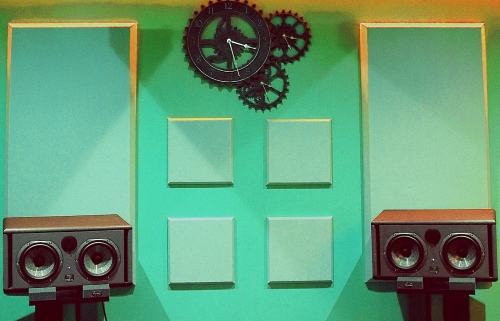A while back I had the pleasure of attending a seminar given by Gavin Haverstick of Haverstick Designs.
The topic of the seminar was how to measure the acoustic issues of your room. He talked about various measurement techniques and devices.
All of this was very interesting, but the most fascinating part for me was during the question-and-answer section at the end. Someone in the audience asked Gavin to give his opinion on digital room correction.
Let me take a step back and explain what I mean by “digital room correction.” There are several products on the market now that can tune studio monitors to the room they are in. For example, if the room is causing a boost at 200 Hz, these products will use a digital EQ to attenuate 200 Hz. The end result is (ideally) a flat frequency response.
The way these products go about measuring the room is by using an omnidirectional measurement microphone to “listen” to the room while the system generates white or pink noise through the studio monitors. Since the generated noise has the same amount of energy (or volume) across the frequency spectrum, the system can then intelligently “hear” when certain frequencies are being either boosted or cut by the acoustics of the room.
The audience member who asked Gavin about room correction owns a pair of JBL LSRs, but he has no acoustic treatment in his home studio. He was basically wanting to know if he could “get away with” just using the room correction feature on the loudspeakers without buying any acoustic treatment.
Two Parts of Acoustics
When talking about acoustically treating a room, we need to look at two different aspects of sound. You can’t focus on just one and negate the other. Likewise, correcting one won’t fix the other. Those two parts are the frequency domain and the time domain of sound.
Frequency Domain
This is the most obvious side of acoustics. We’re all searching for this fabled “flat frequency response.” We know that the size and shape of a room contributes significantly to the frequency response of the room. Ergo (forgive the pun), we must address those frequency issues by altering the frequency response at the source.
This is done with some sort of equalizer. In the past, engineers attempted to do this buy using some sort of graphic EQ. They would send the outputs of their mixing console through an EQ, which they tuned by ear, out to their studio monitors.
Today we have very accurate products. These digital products can EQ a signal with surgical accuracy, but is that enough?
Time Domain
Sound travels fairly slowly (as opposed to light). It only travels at around 1,130 feet per second.
We’ve all experienced this. Two football players hit each other on the other side of the field, and you hear the sound of the collision slightly after you see it.
While it’s not as obvious, the same thing happens in a studio environment. The sound leaves the loudspeakers and bounces around the room.
The problem is this: To accurately hear studio monitors, you need to hear them by themselves, without any reflections from the room. This is why manufacturers measure their speakers in an anechoic chamber, a room that allows for no reflections.
If we are in a large enough room, we can clearly hear the direct sound from the loudspeakers and differentiate that from the delayed sound that is bouncing off of the back wall. However, in most home studios, the room is fairly small, and most reflections happen rather quickly.
Our brains aren’t capable of distinguishing between these early reflections and the direct sound from the monitors. In fact, according to Gavin, any sound that reaches our ears within 50-80 milliseconds of the original sound gets interpreted by our brain as the original sound.
For example, if you have your studio monitors in front of you, and you play a snare drum through them, you’ll first hear the direct sound of the snare. A few milliseconds later your ears will hear the sound after it bounces off the walls to your left and right and also the ceiling above you. Since the walls and ceiling are fairly close, your brain will combine these early reflections with the original sound.
The result? Well, let me ask you this: What if you took a snare track in Pro Tools, duplicated it, and delayed the second track by a few milliseconds—what would you hear? The two tracks would be out of phase with one another. Whenever signals are out of phase, all sorts of issues occur, such as comb filtering (where certain frequencies get cancelled out).
The difference in sound will be rather subtle, but imagine this difference across an entire mix! All those frequencies will be reaching your ear at slightly different times. The result? A very fuzzy mix with little detail.
Conclusion
The problem with digital room correction is that it only addresses the frequency domain. Depending on the room, it may do a rather good job.
However, if your room is causing a 30 dB cut at 100 Hz, these digital systems won’t be able to fix this. Most of them can only boost the signal by something like 6 dB, which isn’t enough to cover the 30 dB lost by your room acoustics.
As far as the time domain goes, I think it’s obvious to note that no amount of EQ will fix this problem.
I’ve used both acoustic treatment and the IK Multimedia ARC system. My findings? I heard an immediate difference as soon as I put up some acoustic foam to the left and right of my loudspeakers. The sound was instantly tighter and more defined. With ARC, there was a difference, but it wasn’t as dramatic.
The goal of this article is not to sway you from digital correction products. They can be a valuable tool in helping create an accurate mixing environment. I love the JBL LSR monitors. They sound amazing, even without any room correction.
Digital room correction, when added to acoustic treatment, can be very effective. However, nothing…I repeat nothing…can replace the need for acoustic treatment.
















